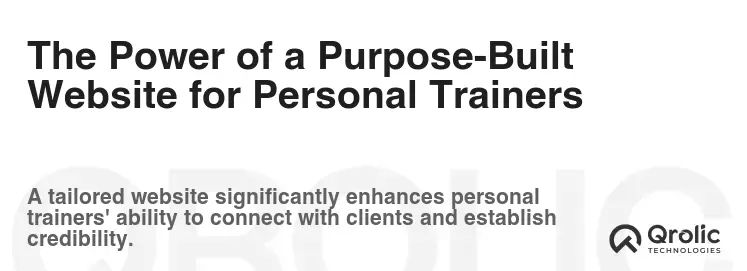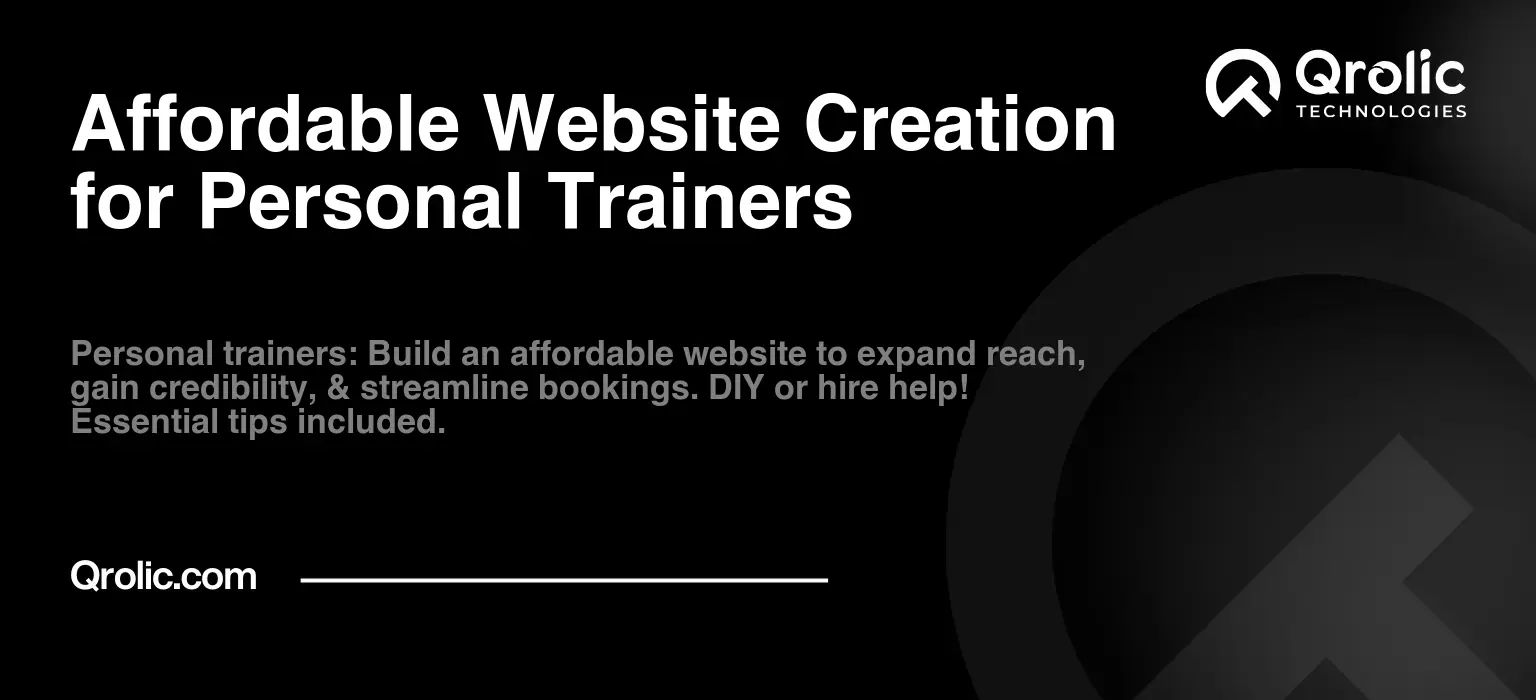Quick Summary:
- A strong website is essential for personal trainers.
- Include core features like services, booking, and testimonials.
- Optimize your site for search engines and promote it.
- Track website performance to attract more clients.
Table of Contents
- The Power of a Purpose-Built Website for Personal Trainers
- Why Every Personal Trainer Needs a Dedicated Website
- Key Website Goals for Personal Trainers
- Core Website Features for Attracting & Converting Clients
- 1. Compelling Homepage Design: Make a Lasting First Impression
- 2. Services Page: Showcase Your Expertise and Offerings
- 3. About Me Page: Build Trust and Personal Connection
- 4. Success Stories/Testimonials: Leverage Social Proof
- 5. Blog: Establish Authority and Provide Value
- 6. Contact Page: Make it Easy to Connect
- 7. Session Booking System: Streamline Appointment Scheduling
- Advanced Website Features to Elevate Your Online Presence
- 8. Personalized Workout Plans: Cater to Individual Needs
- 9. Nutrition Guides and Meal Plans: Holistic Approach to Fitness
- 10. Membership Portal: Build a Community and Recurring Revenue
- 11. Video Content: Engage and Educate Your Audience
- 12. Email Marketing Integration: Nurture Leads and Stay Connected
- Optimizing Your Website for Search Engines (SEO)
- Keyword Research: Identify Relevant Search Terms
- On-Page Optimization: Optimize Your Website Content
- Off-Page Optimization: Build Authority and Backlinks
- Website Speed and Mobile-Friendliness: Essential for SEO
- Promoting Your Website and Growing Your Online Presence
- Social Media Marketing: Engage Your Target Audience
- Paid Advertising: Reach a Targeted Audience
- Email Marketing: Nurture Leads and Stay Connected
- Local SEO: Target Local Clients
- Qrolic Technologies: Your Partner in Building a Successful Website
- Web Development Services
- Digital Marketing Services
- Measuring Your Website’s Success: Key Metrics to Track
The Power of a Purpose-Built Website for Personal Trainers

A website isn’t just an online brochure anymore. For personal trainers, it’s the cornerstone of your brand, your primary lead generation tool, and your virtual storefront. In today’s digital age, potential clients are searching online for fitness solutions, and a well-designed website is crucial for attracting and converting them. It’s where you showcase your expertise, build trust, and ultimately, book more sessions. Think of it as your 24/7 personal assistant, tirelessly promoting your services even while you’re training clients. This section details why a website is not merely an option, but a necessity for thriving in the competitive fitness industry.
Why Every Personal Trainer Needs a Dedicated Website
Expand Your Reach: Limitless possibilities await beyond your local gym or studio. A website extends your reach to potential clients globally, especially with options for online training.
Establish Credibility: A professional website instantly elevates your credibility. It demonstrates that you’re serious about your business and invested in providing a quality service. Displaying certifications, testimonials, and your training philosophy establishes trust with potential clients.
Control Your Narrative: Social media algorithms change, and platforms come and go. Your website is your own piece of internet real estate where you control the message and brand representation.
Generate Leads and Book Sessions: Your website is a lead generation machine. With strategically placed calls-to-action (CTAs) and online booking capabilities, you can seamlessly convert website visitors into paying clients.
Showcase Success Stories: Nothing is more persuasive than real results. Featuring client success stories with before-and-after photos and testimonials on your website can significantly impact potential clients.
Automate Processes: From online consultations to appointment scheduling and payment processing, a website streamlines many administrative tasks, freeing up your time to focus on what you do best: training clients.
Key Website Goals for Personal Trainers
Before diving into specific features, it’s crucial to define your website’s core objectives.
- Attract New Clients: Your website should be a magnet for attracting potential clients searching for fitness trainers online.
- Convert Leads into Clients: Convert website visitors into leads through compelling content, strategic CTAs, and easy ways to contact you.
- Build Your Brand: Communicate your unique training philosophy, personality, and expertise to build a strong personal brand.
- Provide Value to Existing Clients: Offer valuable resources, such as workout plans, nutrition guides, and educational articles, to enhance your client experience and retention.
- Streamline Business Operations: Simplify appointment scheduling, payment processing, and communication with clients through automated website features.
Core Website Features for Attracting & Converting Clients

This section focuses on the fundamental website features that are essential for attracting new clients and converting them into paying customers. It covers everything from showcasing your expertise to facilitating easy communication and booking.
1. Compelling Homepage Design: Make a Lasting First Impression
Your homepage is the first impression you make on potential clients. It needs to be visually appealing, informative, and instantly convey your unique value proposition.
- Above-the-Fold Impact: Capture attention immediately with a striking hero image or video showcasing your training style and results. Include a concise headline that clearly states the benefits of working with you. For example: “Transform Your Body and Achieve Your Fitness Goals with [Your Name]’s Personalized Training Programs.”
- Clear Value Proposition: Clearly communicate what makes you different from other personal trainers. Highlight your specializations, unique training methodologies, or specific client focus.
- Easy Navigation: Ensure your website is easy to navigate, with clear and intuitive menus. Visitors should be able to find what they’re looking for quickly and easily.
- Mobile Responsiveness: In today’s mobile-first world, your website must be fully responsive and optimized for all devices, including smartphones and tablets.
- Prominent Call-to-Action (CTA): Guide visitors to take the next step with clear and compelling CTAs, such as “Book a Free Consultation,” “Download My Free Workout Guide,” or “Contact Me Today.”
2. Services Page: Showcase Your Expertise and Offerings
Your services page is where you detail the specific training programs and services you offer.
- Detailed Descriptions: Provide detailed descriptions of each service, outlining the benefits, duration, and pricing. Use compelling language that resonates with your target audience.
- Packages and Pricing: Clearly outline your packages and pricing options. Consider offering different tiers to cater to various budgets and needs.
- Specializations: Highlight any specializations you have, such as weight loss, strength training, injury rehabilitation, or sports-specific training.
- Online Training Options: If you offer online training, dedicate a section to explain the benefits and how it works.
- High-Quality Images/Videos: Use high-quality images or videos showcasing your training sessions and the results clients have achieved.
3. About Me Page: Build Trust and Personal Connection
Your About Me page is your opportunity to connect with potential clients on a personal level and build trust.
- Your Story: Share your story and passion for fitness. Explain why you became a personal trainer and what motivates you.
- Qualifications and Certifications: List your relevant qualifications, certifications, and experience. This establishes your credibility and expertise.
- Training Philosophy: Articulate your training philosophy and approach. Explain how you tailor your programs to meet individual client needs.
- Personal Touch: Include personal details, such as your hobbies and interests, to create a more relatable and human connection.
- Professional Photo: Use a professional headshot or photo of you in action, training clients.
4. Success Stories/Testimonials: Leverage Social Proof
Client success stories and testimonials are powerful social proof that can significantly influence potential clients’ decisions. fitness trainer website.
- Real Results: Showcase real results with before-and-after photos and detailed accounts of clients’ transformations.
- Specific and Relatable: Use testimonials that are specific and relatable, highlighting the specific benefits clients have experienced working with you.
- Variety of Clients: Feature a variety of clients with different backgrounds, goals, and fitness levels to appeal to a broader audience.
- Video Testimonials: Consider incorporating video testimonials for an even more impactful and authentic presentation.
- Consent is Key: Always obtain consent from clients before featuring their photos or testimonials on your website.
5. Blog: Establish Authority and Provide Value
A blog is a valuable tool for establishing yourself as an authority in the fitness industry and providing valuable content to attract and engage potential clients.
- Targeted Content: Create blog posts that address common fitness concerns and questions from your target audience.
- SEO Optimization: Optimize your blog posts for relevant keywords to improve your website’s search engine ranking.
- Valuable Information: Provide practical tips, workout routines, nutrition advice, and informative articles on various fitness topics.
- Consistent Posting: Maintain a consistent posting schedule to keep your blog fresh and engaging.
- Promote Your Services: Subtly promote your services within your blog posts by providing links to your services page or offering free resources in exchange for contact information.
6. Contact Page: Make it Easy to Connect
Your contact page should make it easy for potential clients to reach you.
- Contact Form: Include a contact form with fields for name, email, phone number, and message.
- Email Address and Phone Number: Display your email address and phone number prominently.
- Social Media Links: Include links to your social media profiles.
- Location (if applicable): If you have a physical location, include your address and a map.
- Call to Action: Encourage visitors to contact you by including a clear CTA, such as “Get in Touch,” “Schedule a Free Consultation,” or “Ask Me a Question.”
7. Session Booking System: Streamline Appointment Scheduling
Implementing a session booking system streamlines the appointment scheduling process, making it easy for clients to book sessions online 24/7.
- Real-Time Availability: Integrate a calendar that displays your real-time availability.
- Online Payments: Allow clients to pay for sessions online through a secure payment gateway.
- Automated Reminders: Send automated email or SMS reminders to clients about their upcoming appointments.
- Client Portal: Provide a client portal where clients can manage their appointments, view their training history, and access personalized workout plans.
- Mobile-Friendly Interface: Ensure the booking system is mobile-friendly and easy to use on all devices.
Advanced Website Features to Elevate Your Online Presence

Beyond the core features, these advanced functionalities can significantly enhance your website and provide a competitive edge.
8. Personalized Workout Plans: Cater to Individual Needs
Offering personalized workout plans is a powerful way to provide value to your clients and differentiate yourself from other trainers.
- Assessment Forms: Integrate assessment forms to gather information about clients’ fitness levels, goals, and preferences.
- Customized Plans: Create customized workout plans based on individual client needs and goals.
- Exercise Library: Include an exercise library with videos and descriptions of proper form and technique.
- Progress Tracking: Allow clients to track their progress and monitor their results.
- Integration with Fitness Trackers: Integrate with popular fitness trackers to automatically sync data and monitor client activity.
9. Nutrition Guides and Meal Plans: Holistic Approach to Fitness
Providing nutrition guidance is an essential component of a holistic fitness approach.
- Recipe Database: Create a recipe database with healthy and delicious meal options.
- Meal Planning Tools: Offer meal planning tools that allow clients to create customized meal plans based on their dietary needs and preferences.
- Nutritional Education: Provide educational resources on nutrition, macronutrients, and healthy eating habits.
- Supplement Recommendations: Offer guidance on supplements that can support clients’ fitness goals (while always emphasizing the importance of consulting with a healthcare professional).
- Integration with Food Tracking Apps: Integrate with food tracking apps to allow clients to easily track their calorie and macronutrient intake.
10. Membership Portal: Build a Community and Recurring Revenue
A membership portal can help you build a loyal community and generate recurring revenue.
- Exclusive Content: Offer exclusive content, such as workout videos, nutrition guides, and live Q&A sessions, to members only.
- Community Forum: Create a community forum where members can connect with each other, share their progress, and ask questions.
- Premium Services: Offer premium services, such as personalized coaching or access to exclusive events, to members at a discounted rate.
- Different Membership Tiers: Offer different membership tiers with varying levels of access and benefits.
- Automated Billing: Automate the billing process for recurring membership fees.
11. Video Content: Engage and Educate Your Audience
Video content is highly engaging and can be used to showcase your expertise, provide workout demonstrations, and share valuable fitness tips.
- Workout Demonstrations: Create videos demonstrating proper form and technique for various exercises.
- Educational Videos: Share educational videos on fitness topics, such as nutrition, injury prevention, and exercise science.
- Client Testimonials: Feature video testimonials from satisfied clients.
- Live Streams: Host Live Streams to answer questions, provide real-time coaching, and engage with your audience.
- YouTube Channel: Create a YouTube channel to host your video content and expand your reach.
12. Email Marketing Integration: Nurture Leads and Stay Connected
Email marketing is a powerful tool for nurturing leads, staying connected with clients, and promoting your services.
- Email List Signup Form: Include an email list signup form on your website to capture leads.
- Automated Email Sequences: Create automated email sequences to welcome new subscribers, provide valuable content, and promote your services.
- Targeted Email Campaigns: Segment your email list and send targeted email campaigns based on subscriber interests and behaviors.
- Promotional Emails: Send promotional emails to announce special offers, new services, or upcoming events.
- Email Marketing Platform: Use an email marketing platform, such as Mailchimp or ConvertKit, to manage your email list and automate your email campaigns.
Optimizing Your Website for Search Engines (SEO)

Having a beautiful and functional website is only half the battle. You also need to optimize it for search engines so potential clients can find you online. fitness trainer website.
Keyword Research: Identify Relevant Search Terms
Keyword research is the foundation of any successful SEO strategy.
- Brainstorming: Brainstorm a list of relevant keywords that potential clients might use when searching for personal trainers in your area.
- Keyword Research Tools: Use keyword research tools, such as Google Keyword Planner or Ahrefs, to identify high-volume, low-competition keywords.
- Long-Tail Keywords: Focus on long-tail keywords, which are longer and more specific search phrases that often have lower competition. For example, instead of “personal trainer,” try “personal trainer for weight loss in [city].”
- Local Keywords: Incorporate local keywords to target clients in your geographic area. For example, “[city] personal trainer” or “personal trainer near me.”
- Analyze Competitors: Analyze your competitors’ websites to identify the keywords they are targeting.
On-Page Optimization: Optimize Your Website Content
On-page optimization involves optimizing the content on your website to improve its search engine ranking.
- Title Tags: Optimize your title tags with relevant keywords.
- Meta Descriptions: Write compelling meta descriptions that encourage users to click on your search result.
- Header Tags: Use header tags (H1, H2, H3, etc.) to structure your content and incorporate relevant keywords.
- Keyword Density: Use keywords naturally throughout your content, but avoid keyword stuffing.
- Image Optimization: Optimize your images with descriptive file names and alt tags.
- Internal Linking: Link to other relevant pages on your website to improve navigation and SEO.
Off-Page Optimization: Build Authority and Backlinks
Off-page optimization involves building authority and backlinks to your website from other reputable websites.
- Backlink Building: Earn backlinks from other websites by creating high-quality content that people want to link to.
- Guest Blogging: Write guest posts for other websites in your industry and include a link back to your website.
- Directory Listings: List your website in relevant online directories.
- Social Media Promotion: Promote your website and content on social media.
- Local SEO: Focus on local SEO by claiming your Google My Business listing and encouraging clients to leave reviews.
Website Speed and Mobile-Friendliness: Essential for SEO
Website speed and mobile-friendliness are critical ranking factors for search engines.
- Optimize Images: Compress images to reduce file size without sacrificing quality.
- Leverage Browser Caching: Enable browser caching to store frequently accessed files on users’ devices.
- Minimize HTTP Requests: Reduce the number of HTTP requests your website makes.
- Mobile-Friendly Design: Use a responsive design that adapts to different screen sizes.
- Google’s Mobile-Friendly Test: Use Google’s Mobile-Friendly Test to ensure your website is mobile-friendly.
Promoting Your Website and Growing Your Online Presence

Creating a great website is only the first step. You also need to actively promote it to attract visitors and generate leads.
Social Media Marketing: Engage Your Target Audience
Social media is a powerful tool for engaging your target audience, building your brand, and driving traffic to your website.
- Choose the Right Platforms: Focus on the social media platforms that your target audience uses most.
- Create Engaging Content: Create engaging content that is relevant to your target audience.
- Consistent Posting: Post consistently to keep your audience engaged.
- Run Contests and Giveaways: Run contests and giveaways to generate excitement and increase engagement.
- Use Hashtags: Use relevant hashtags to reach a wider audience.
Paid Advertising: Reach a Targeted Audience
Paid advertising can be a cost-effective way to reach a targeted audience and generate leads.
- Google Ads: Use Google Ads to target potential clients who are searching for personal trainers online.
- Social Media Ads: Use social media ads to target potential clients based on their interests, demographics, and behaviors.
- Retargeting: Use retargeting ads to target website visitors who have not yet converted into clients.
- Track Your Results: Track your results to see which ads are performing best and optimize your campaigns accordingly.
Email Marketing: Nurture Leads and Stay Connected
Email marketing is a powerful tool for nurturing leads, staying connected with clients, and promoting your services.
- Email List Signup Form: Include an email list signup form on your website to capture leads.
- Automated Email Sequences: Create automated email sequences to welcome new subscribers, provide valuable content, and promote your services.
- Targeted Email Campaigns: Segment your email list and send targeted email campaigns based on subscriber interests and behaviors.
- Promotional Emails: Send promotional emails to announce special offers, new services, or upcoming events.
Local SEO: Target Local Clients
Local SEO is essential for attracting clients in your geographic area.
- Google My Business: Claim and optimize your Google My Business listing.
- Local Citations: List your business in relevant online directories.
- Reviews: Encourage clients to leave reviews on Google and other review sites.
- Local Keywords: Incorporate local keywords into your website content and marketing materials.
Qrolic Technologies: Your Partner in Building a Successful Website

Qrolic Technologies is a leading web development and digital marketing company that can help you build a successful website and grow your online presence.
Web Development Services
Qrolic Technologies offers a range of web development services tailored to the specific needs of personal trainers:
- Custom Website Design: We create custom websites that are visually appealing, user-friendly, and optimized for conversions.
- Responsive Design: We ensure your website is fully responsive and optimized for all devices, including smartphones and tablets.
- E-commerce Integration: We integrate e-commerce functionality to allow you to sell online training programs, nutrition guides, and other products.
- Session Booking System: We integrate a session booking system to streamline appointment scheduling and payment processing.
- Membership Portal: We develop membership portals to help you build a community and generate recurring revenue.
Digital Marketing Services
Qrolic Technologies also offers a range of digital marketing services to help you attract visitors to your website and generate leads:
- SEO: We optimize your website for search engines to improve its ranking and attract more organic traffic.
- Social Media Marketing: We help you create engaging content and manage your social media presence to build your brand and reach a wider audience.
- Paid Advertising: We create and manage paid advertising campaigns on Google and social media to reach a targeted audience and generate leads.
- Email Marketing: We help you build an email list, create automated email sequences, and send targeted email campaigns to nurture leads and stay connected with clients.
- Content Marketing: We create high-quality content that is relevant to your target audience and helps you establish yourself as an authority in the fitness industry.
By leveraging the power of a well-designed website and strategic digital marketing, you can attract new clients, build your brand, and achieve your business goals. Qrolic Technologies is your trusted partner in helping you succeed in the competitive fitness industry.
Measuring Your Website’s Success: Key Metrics to Track

Understanding how your website is performing is crucial for making informed decisions and optimizing your online strategy. Here are some key metrics to track:
- Website Traffic: Track the number of visitors to your website, including unique visitors, page views, and bounce rate. Use Google Analytics to monitor these metrics.
- Lead Generation: Track the number of leads generated through your website, such as contact form submissions, email list signups, and phone calls.
- Conversion Rate: Track the percentage of website visitors who convert into clients. This metric helps you understand how effectively your website is converting traffic into paying customers.
- Session Booking Rate: Track the number of sessions booked through your online booking system.
- Website Ranking: Track your website’s ranking for relevant keywords in search engine results pages (SERPs). Use keyword tracking tools to monitor your ranking.
- Social Media Engagement: Track the engagement on your social media profiles, such as likes, shares, comments, and followers.
- Return on Investment (ROI): Calculate the ROI of your website and digital marketing efforts to determine the effectiveness of your investments.
By monitoring these metrics, you can identify areas for improvement and optimize your website and marketing strategy to achieve your business goals. success stories








